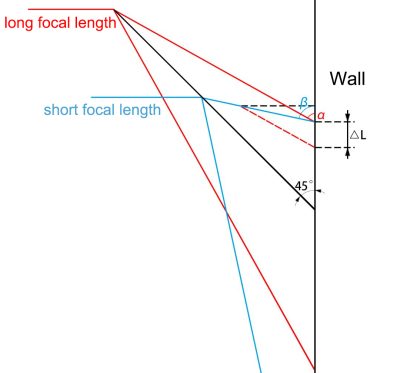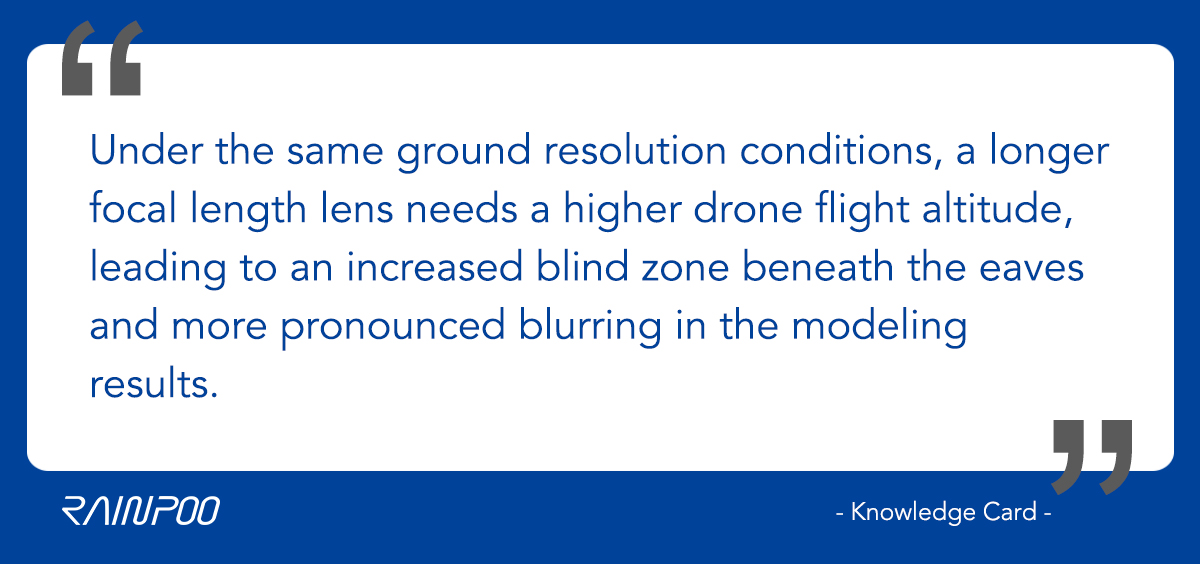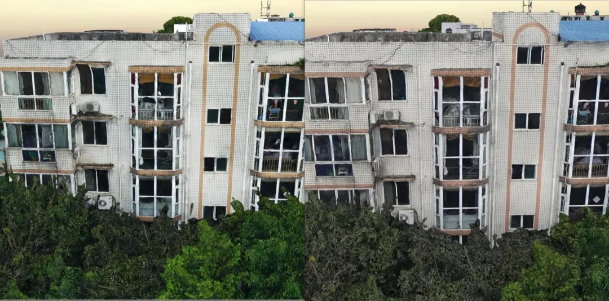Background
In aerial survey operations, various geographical challenges are often encountered. Particularly in regions with significant elevation differences, complex terrains, and diverse landforms (including high-voltage lines, chimneys, and base stations), the safety of drone flights is severely affected.
In practical operations, we frequently come across situations where clients' failure to plan the flight altitude properly leads to collisions or impacts between drones and high-voltage lines or base stations. Sometimes, although the drones narrowly avoid the danger zones, it is only during the inspection of the aerial images that we realize the proximity between the drones and the risks. These risks and potential hazards often result in significant property losses for clients.
So, how can we ensure both safety distances and modeling effectiveness during drone operations?
1. Decoding the Relationship: Focal Length and Modeling Effectiveness
There is a common misconception among many clients regarding the relationship between focal length and modeling effectiveness. Some manufacturers of oblique photography cameras even mistakenly believe that longer focal length lenses enhance modeling results.
In reality, for urban facade modeling scenarios, under similar conditions with other parameters, longer focal lengths actually result in poorer modeling outcomes.
The relationship between focal length and FOV (field of view) is as follows: under similar conditions with other parameters, focal length only affects the flight altitude.

The diagram below illustrates two lenses, with the red representing a long focal length lens and the blue representing a short focal length lens. For a wall surface, the maximum angle formed by the long focal length lens is α, while the maximum angle formed by the short focal length lens is β.

Obviously, β > α.
What significance does this angle hold? The size of the angle reflects the level of horizontal alignment between the lens's FOV (field-of-view) edges and the wall surface. When capturing facade information of buildings, a short focal length lens can capture the wall surface more horizontally, resulting in a more accurate representation of facade textures in the model.
Therefore, when photographing scenes with facades, a shorter focal length leads to a richer collection of facade information and, consequently, better modeling outcomes. As mentioned earlier, for scenes with eaves, the modeling results using the D3M camera are not as effective as the D2M camera.
This is because, under the same ground resolution conditions, a longer focal length lens necessitates a higher drone flight altitude, leading to an increased blind zone beneath the eaves and more pronounced blurring in the modeling results.

The dotted line in the diagram represents the eaves, and the obstructed portion of the field of view is relatively larger for the long focal length lens. Hence, in such scenarios, the D3M camera with a longer focal length lens produces more severe blurring in the modeled data compared to the D2M camera.

2. The Dilemma of Practical Applications: The Contradiction between Flight Altitude and Effectiveness
Based on the aforementioned logic of focal length and modeling outcomes, if the lens focal length is sufficiently short and the field of view angle is wide enough, there is actually no need for multiple lenses. A single ultra-wide-angle lens (fisheye lens) can capture all directional perspective information. Is an ultra-short lens focal length the ultimate solution to all problems? Clearly, the answer is negative.
Setting aside the issue of significant distortion caused by extremely short focal lengths, let's consider a scenario where the focal length of the DG3pros oblique camera is designed to be 10mm. With a data resolution of 1cm, the drone's flight altitude would be as low as 25 meters. If a drone equipped with such a design were to go out for operations, it would undoubtedly encounter numerous hazards.

Aerial image captured with an ultra-wide-angle lens
3. RainpooInsights: Exploring the Journey from D2M to D3M
During the product development process at Rainpoo, we have delved into the balance between flight altitude and effectiveness.
Initially, the D2M was developed as a high-precision modeling tool specifically designed for cadastral survey projects, suitable for modeling scenes with flat terrains and low-rise buildings.

However, numerous clients expressed their demand: Could we design a long focal length oblique camera to increase operational altitude and enhance safety?
In response to these customer needs, we introduced the D3M, a long focal length version (with 50mm/75mm focal lengths) built upon the foundation of the D2M. Compared to the D2M, the D3M significantly increases the operational flight altitude of the drone by approximately 100% while maintaining the same resolution.
During the development of the D3M, Rainpoo's R&D team believed that a longer focal length would enable higher flight altitudes, better modeling outcomes, and improved data accuracy. However, it was only during practical operations that we discovered an occurrence of blurring in the models created with the D3M, particularly beneath eaves, resulting in relatively lower efficiency compared to the D2M.
Rainpoo does not stop there but continues its research on achieving a better balance between flight altitude and modeling effectiveness.
4. Selection of Focal Length: Optimization Strategies in Oblique Photography
The empirical data from D3M has led us to realize that, for oblique photography, the pursuit of longer or shorter focal lengths alone is not the solution. The choice of focal length is closely related to the modeling effectiveness, flight efficiency, and operational altitude.
1) The technical formula relative to flight altitude is expressed as:
H = f * GSD / a;
H: relative flight altitude
f: focal length of the camera lens
GSD: image ground sampling distance
a: size of the pixel

From the formula, we can observe that:
The relative flight altitude (H) and lens focal length (f) are proportional in nature, and the image resolution (GSD) determines the slope of the function. Whether you increase or decrease the focal length, the marginal utility of changes in flight altitude remains constant.
In other words, adjusting the focal length does not alter the impact of marginal changes in flight altitude. Regardless of whether you use a long or short focal length lens, as long as you maintain a consistent relative flight altitude, the effect on image resolution will remain consistent.

2) The lens field of view can be expressed using the following formula:
θ = 2arctan(d/2f);
θ: lens field of view (fov)
d: sensor size
f: equivalent focal length of the lens
From the formula, we can understand that: The lens field of view (θ) is an inverse tangent function of the lens focal length (f). When the focal length (f) approaches zero, the lens FOV (field of view) approaches 180°, also known as a fisheye lens.

The function graph is shown in the above figure: as the lens focal length (f) approaches infinity, the lens FOV (field of view) becomes infinitely small. In the shorter focal length range, the function exhibits a steeper slope, indicating that changes in focal length have a higher marginal utility in improving the modeling effect.
As the focal length of the lens becomes longer and longer, the slope of the function gradually decreases. When the focal length increases infinitely, the slope approaches zero. This means that as the focal length increases, the marginal utility of improving the model's effectiveness diminishes. In other words, even if you continue to increase the focal length, the improvement in the shooting effect will become smaller and almost negligible.

5. Seeking the Golden Point of Focal Length: RainpooDeveloped DG3M Oblique Photography Camera
Based on the aforementioned principles, the primary challenge we faced during lens development was: How do we choose the appropriate focal length value? A short focal length can provide excellent modeling results but poses safety risks due to low flight altitudes. To ensure flight safety, we must design the focal length to be longer, but blindly increasing it can impact operational efficiency and modeling effectiveness. There exists a certain contradiction between flight altitude and modeling effectiveness, and we must find a balance within these contradictions.
Considering these conflicting factors, Rainpoo has developed the DG3M oblique photography camera, building upon the foundation of D2M and D3M. The DG3M camera combines the outstanding performance of D2M while considering the suitable flight altitudes of D3M.

Through Rainpoo's efforts, we have achieved a breakthrough at the compromise point of focal length selection. The DG3M oblique photography camera becomes a solution that balances various factors, bringing new possibilities to the field of oblique photography.










